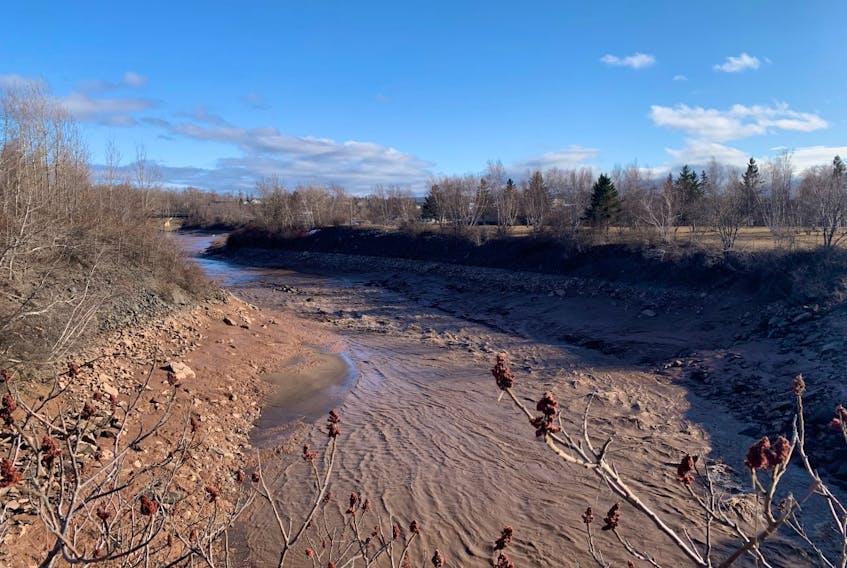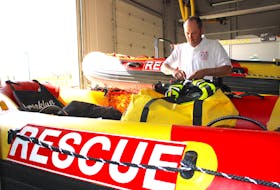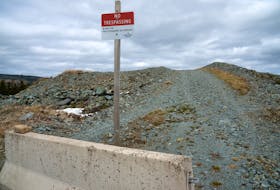The province’s controversial promises to protect farmland, a canoe club, wells and fish passage with a new Windsor causeway has yet to prove its merits to Fisheries and Oceans Canada.
Despite having been submitted for a Fisheries Act approval on Nov. 5, DFO has not given the project the green light.
Asked this week whether rumours that the province’s plan to allow fish passage was found lacking by the regulator were true, government responded with: “The Transportation and Transit Department is continuing to work with DFO on the design of the new structure that will be required,” wrote Department of Agriculture spokesman Bruce Nunn in an email.
“Those discussions are ongoing. At this time, those discussions have not impacted the timeline for the 101 twinning, scheduled to be complete by the end of 2023.”
According to an Oct. 7 project update by the Department of Transportation and Infrastructure Renewal, final design and specifications on the Avon River aboiteau replacement and Windsor causeway upgrade were supposed to be complete by “early 2021” so that construction could begin this fall and be done by late 2022.

The project involves expanding the existing Windsor causeway across the Avon River to accommodate four lanes of traffic, installing two fishways to allow passage of aquatic species upstream and a new aboiteau. The latter are like big doors that the Department of Agriculture opens and closes to maintain water levels in Lake Pisiquid, created when the original causeway was opened in 1970.
Beyond creating a manmade lake, that causeway accomplished two things:
- It replaced 26 kilometres of dikes and 34 smaller aboiteaus protecting farmland and wells from the saltwater that surges upstream during high tide.
- It largely cut off fish passage up one of the province’s major river systems.
Last week, federal Fisheries Minister Bernadette Jordan ordered the province to open the gates in the existing causeway, drain Lake Pisiquid and allow at least 10 minutes of saltwater to pass upstream on each high tide. She justified the order under a clause in the Fisheries Act requiring the province to “maintain at all times the characteristics of the water and the water flow downstream of the obstruction or thing that are sufficient for the conservation and protection of the fish and fish habitat …”
Her department signaled this week that the order would be renewed in two-week increments until around June 15.
It was the first order of its kind for the Avon River, but fits with changing public attitudes toward how we cross rivers.

Between 1950 and 1980, causeways were built across major rivers in Atlantic Canada because they were cheaper than bridges and allowed control of tidal flood waters. The Halfway, Annapolis and Peticodiac rivers on the Bay of Fundy all got causeways with little to no consideration for fish passage.
A growing public concern for the environment saw the gates opened on the causeway crossing the Peticodiac River to link Riverview with Moncton in 2010. The causeway is scheduled to be demolished and replaced by a bridge this year.
The tidal turbine in the causeway blocking the Annapolis River has been shut down after a public outcry over fish kills there.
And now the battle has moved to the Windsor causeway, whose new aboiteau is expected to dictate the future of fish passage and land protection for at least the next half-century.
A group of First Nation-led activists have been holding a 24-hour daily vigil on the river since last May, monitoring the opening and closing of the existing gates.
“(The province’s current proposal) is not adequate. They have said themselves that it wouldn’t ensure fish passage year-round because water levels wouldn’t be high enough,” said Zachary Paul, treasurer of the Treaty Truckhouse 2 Society that has held the vigil.
“We are seeking responsible, ecological management, ideally in the form of bridges and dikes.”
But those dikes and aboiteaus that once protected over a thousand hectares of farmland up river from the causeway have been allowed to deteriorate since being made redundant by the Windsor causeway.
“Everybody wants fish passage,” said Victor Oulton, who runs the mixed farm W. G. Oulton and Sons Ltd. in Martock.
“Just the way global warming is affecting our climate, fresh water all over the world is becoming more of a commodity. We have a chance here to preserve for about 3,000 acres of farmland.”
As the fifth generation Oulton to farm in Martock, Victor argued the requirements of agriculture have evolved along with markets since the causeway has been put in.
Higher value crops are planted that require more water, climate change has seen dryer summers and rising sea levels make the protection afforded by the causeway all the more important.
In what is widely expected to be an election year, Jordan was already at the centre of a debate around the moderate livelihood fishery.
Now, she can add to that a struggle over a river’s future that involves agriculture, municipal planning, highway infrastructure, home owners, fish passage and First Nations.









